Abstract
The overall objective of these studies was to determine whether IgG antibody to Pseudomonas aeruginosa would modify the acute lung and pleural injury that developed over 24 h after the instillation of 10(10) live P. aeruginosa into the distal airspaces of one lung in unanesthetized sheep. Using a quantitative experimental model to measure protein permeability across the alveolar epithelial, lung endothelial, and pleural mesothelial barriers, the effect of IgG antibody to P. aeruginosa was examined under four different experimental conditions. First, the effect of IgG antibody to P. aeruginosa in the circulation was examined by instilling 10(10) live P. aeruginosa in 5% ovine albumin in sheep that had been vaccinated. Under these conditions, the presence of circulating IgG antibody to P. aeruginosa reduced lung endothelial injury but did not modify the lung epithelial or pleural injury caused by intraalveolar P. aeruginosa. Therefore, the second experimental protocol determined the effect of instilling immune serum from a sheep that had been vaccinated so that IgG antibody to P. aeruginosa was present in both the circulation and in the airspaces along with instillation of live bacteria. Under these conditions, injury to the lung endothelium, alveolar epithelium, and pleural space was completely prevented. Therefore, the third protocol examined the protective effect of instillation of IgG antibody to P. aeruginosa in the airspaces concurrent with the live bacteria. Interestingly, intraalveolar IgG antibody to P. aeruginosa prevented all evidence of lung epithelial and pleural injury, and this effect was associated with a marked decrease in the number of viable bacteria in the lung after 24 h. Therefore, the fourth protocol examined the prophylactic effect of instillation of the specific IgG antibody to P. aeruginosa 24 h before instillation of the bacteria. With this prophylactic regimen, epithelial, endothelial, and pleural injury were prevented, and there was a significant decrease in the number of bacteria recovered from the lung. Thus, delivery of IgG antibody to P. aeruginosa the distal airspaces of the lung alone may provide a novel therapeutic approach to preventing acute pulmonary infection caused by P. aeruginosa.
Full text
PDF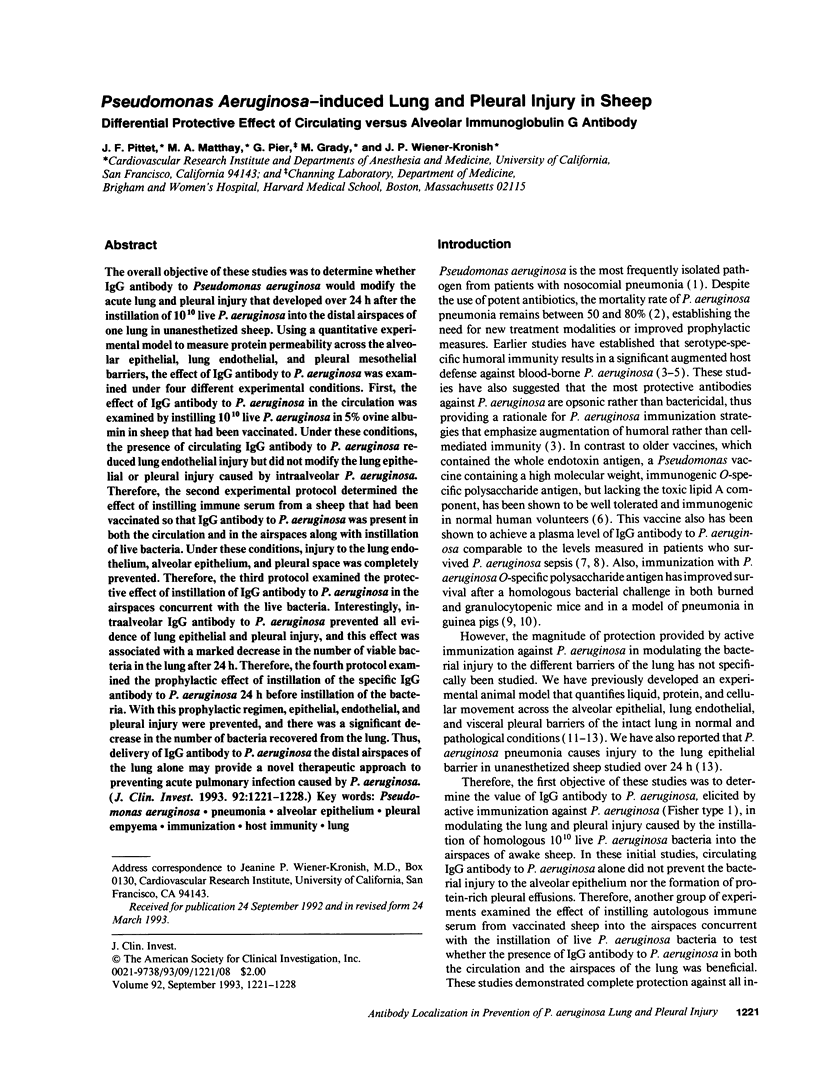
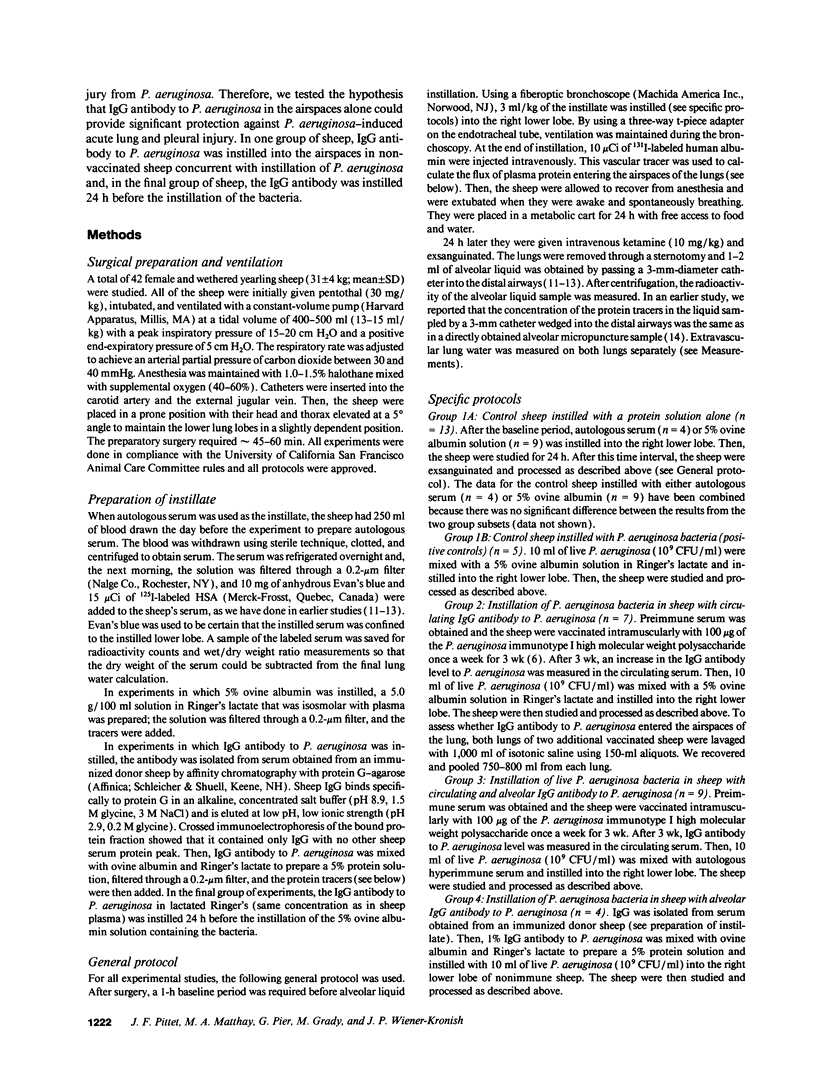
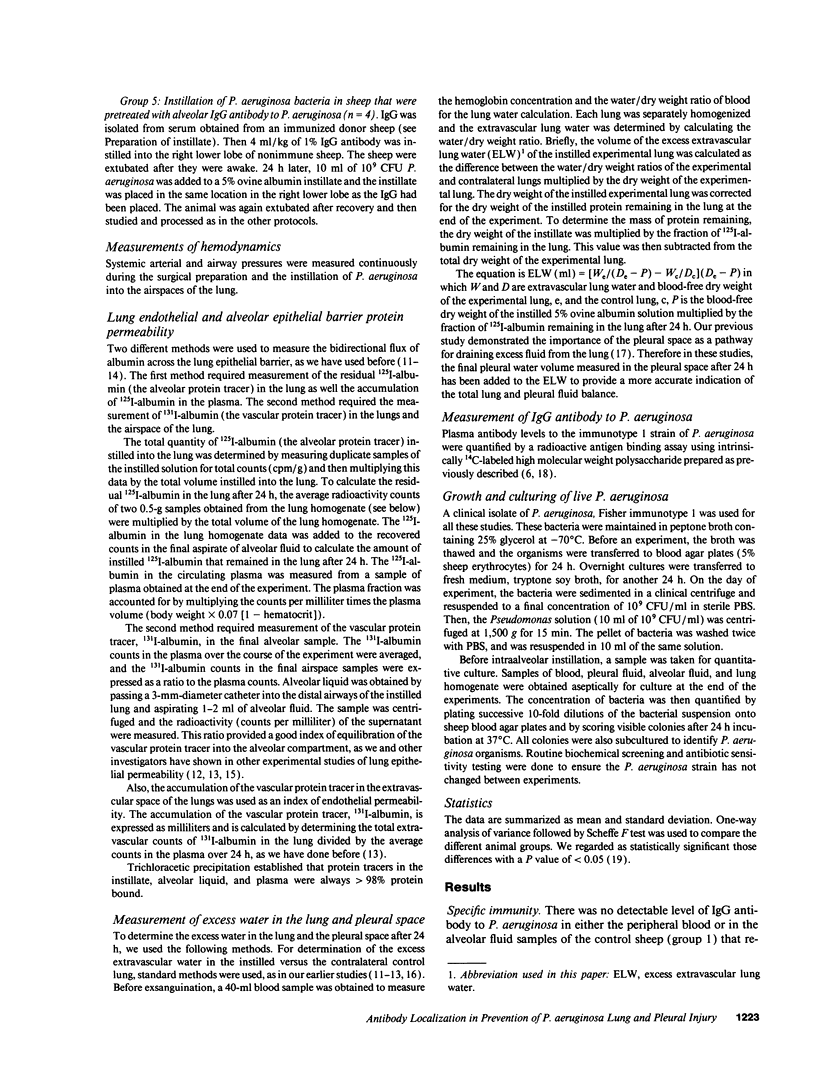
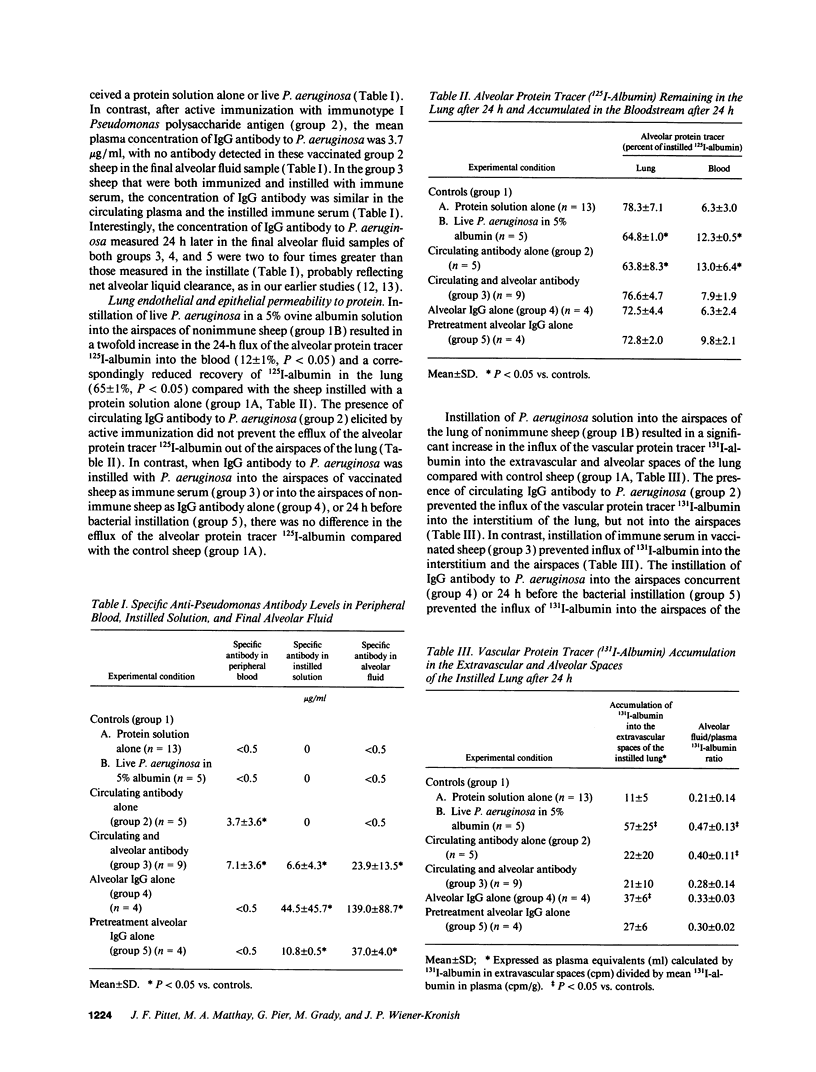
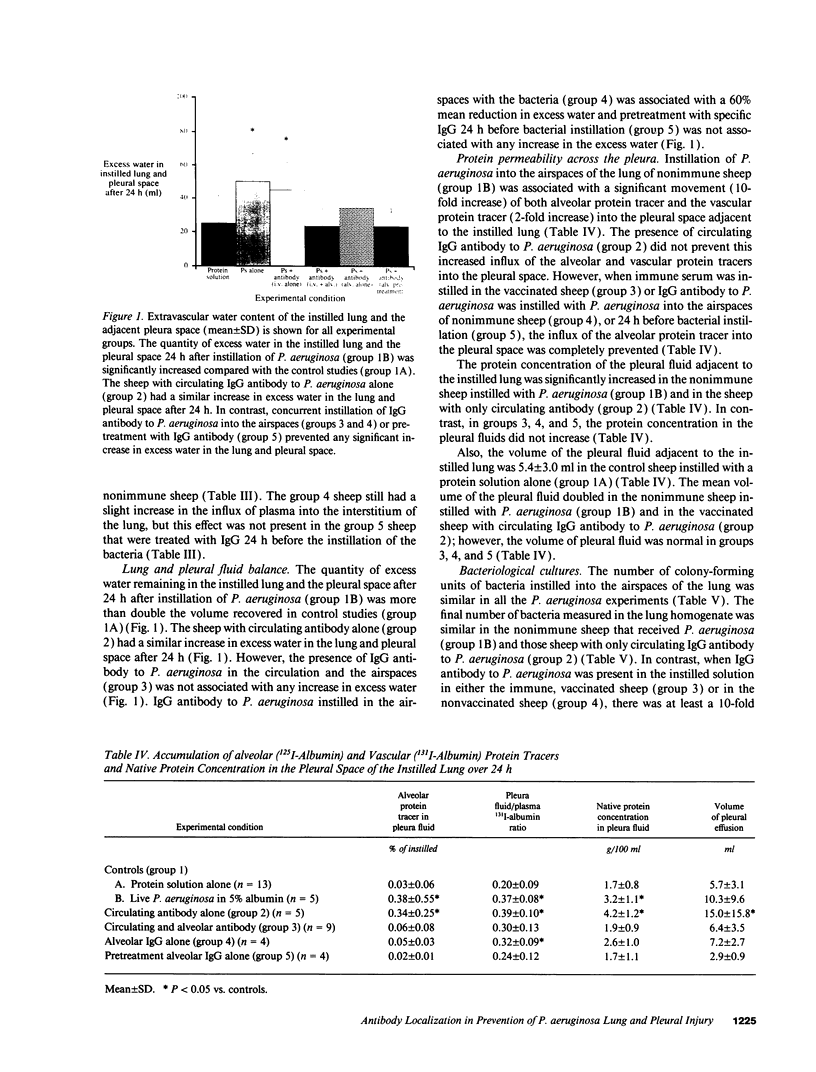
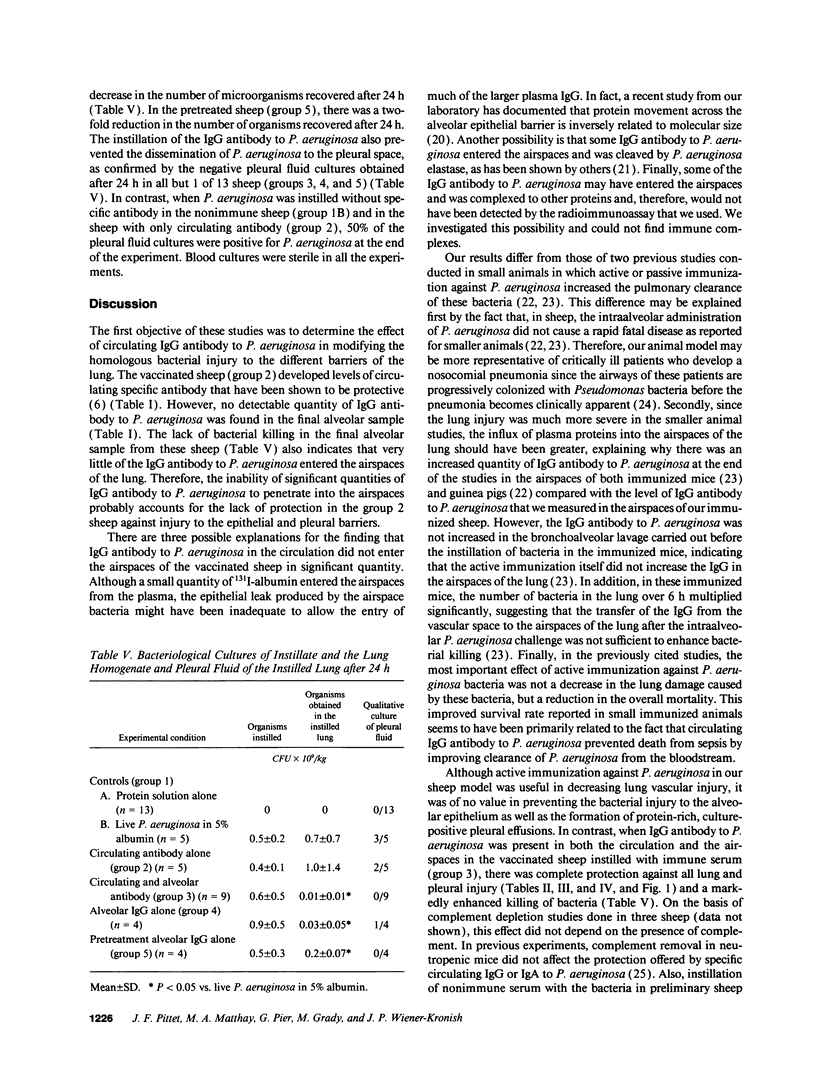
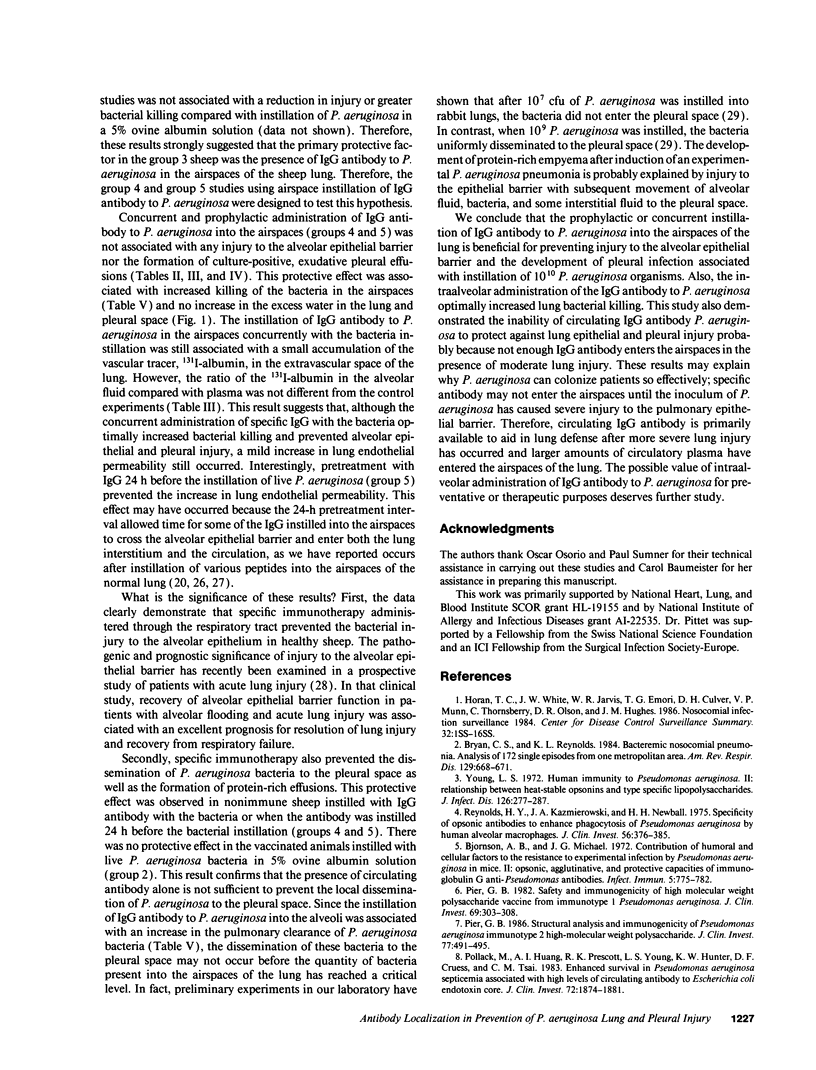
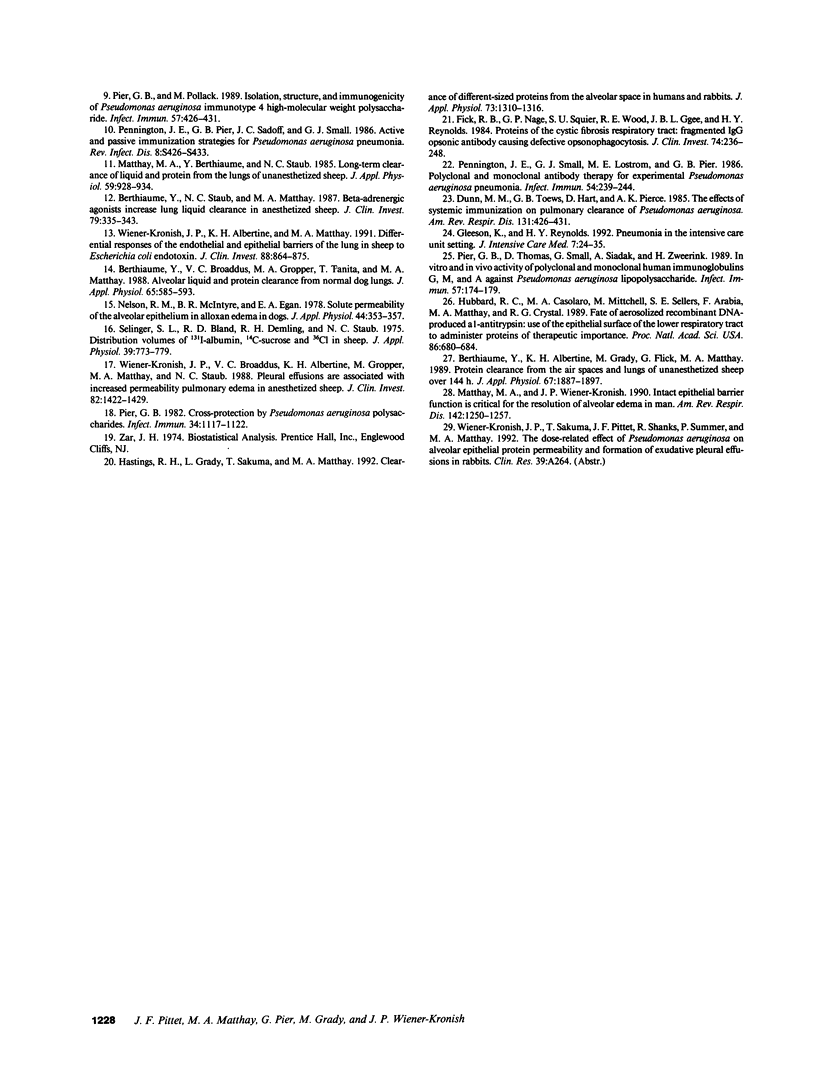
Images in this article
Selected References
These references are in PubMed. This may not be the complete list of references from this article.
- Berthiaume Y., Albertine K. H., Grady M., Fick G., Matthay M. A. Protein clearance from the air spaces and lungs of unanesthetized sheep over 144 h. J Appl Physiol (1985) 1989 Nov;67(5):1887–1897. doi: 10.1152/jappl.1989.67.5.1887. [DOI] [PubMed] [Google Scholar]
- Berthiaume Y., Broaddus V. C., Gropper M. A., Tanita T., Matthay M. A. Alveolar liquid and protein clearance from normal dog lungs. J Appl Physiol (1985) 1988 Aug;65(2):585–593. doi: 10.1152/jappl.1988.65.2.585. [DOI] [PubMed] [Google Scholar]
- Berthiaume Y., Staub N. C., Matthay M. A. Beta-adrenergic agonists increase lung liquid clearance in anesthetized sheep. J Clin Invest. 1987 Feb;79(2):335–343. doi: 10.1172/JCI112817. [DOI] [PMC free article] [PubMed] [Google Scholar]
- Bjornson A. B., Michael J. G. Contribution of humoral and cellular factors to the resistance to experimental infection by Pseudomonas aeruginosa in mice. II. Opsonic, agglutinative, and protective capacities of immunoglobulin G anti-Pseudomonas antibodies. Infect Immun. 1972 May;5(5):775–782. doi: 10.1128/iai.5.5.775-782.1972. [DOI] [PMC free article] [PubMed] [Google Scholar]
- Bryan C. S., Reynolds K. L. Bacteremic nosocomial pneumonia. Analysis of 172 episodes from a single metropolitan area. Am Rev Respir Dis. 1984 May;129(5):668–671. doi: 10.1164/arrd.1984.129.5.668. [DOI] [PubMed] [Google Scholar]
- Dunn M. M., Toews G. B., Hart D., Pierce A. K. The effects of systemic immunization of pulmonary clearance of Pseudomonas aeruginosa. Am Rev Respir Dis. 1985 Mar;131(3):426–431. doi: 10.1164/arrd.1985.131.3.426. [DOI] [PubMed] [Google Scholar]
- Fick R. B., Jr, Naegel G. P., Squier S. U., Wood R. E., Gee J. B., Reynolds H. Y. Proteins of the cystic fibrosis respiratory tract. Fragmented immunoglobulin G opsonic antibody causing defective opsonophagocytosis. J Clin Invest. 1984 Jul;74(1):236–248. doi: 10.1172/JCI111407. [DOI] [PMC free article] [PubMed] [Google Scholar]
- Gleeson K., Reynolds H. Y. Pneumonia in the intensive care unit setting. J Intensive Care Med. 1992 Jan-Feb;7(1):24–35. doi: 10.1177/088506669200700104. [DOI] [PubMed] [Google Scholar]
- Hastings R. H., Grady M., Sakuma T., Matthay M. A. Clearance of different-sized proteins from the alveolar space in humans and rabbits. J Appl Physiol (1985) 1992 Oct;73(4):1310–1316. doi: 10.1152/jappl.1992.73.4.1310. [DOI] [PubMed] [Google Scholar]
- Hubbard R. C., Casolaro M. A., Mitchell M., Sellers S. E., Arabia F., Matthay M. A., Crystal R. G. Fate of aerosolized recombinant DNA-produced alpha 1-antitrypsin: use of the epithelial surface of the lower respiratory tract to administer proteins of therapeutic importance. Proc Natl Acad Sci U S A. 1989 Jan;86(2):680–684. doi: 10.1073/pnas.86.2.680. [DOI] [PMC free article] [PubMed] [Google Scholar]
- Hughes J. M., Culver D. H., White J. W., Jarvis W. R., Morgan W. M., Munn V. P., Mosser J. L., Emori T. G. Nosocomial infection surveillance, 1980-1982. MMWR CDC Surveill Summ. 1983;32(4):1SS–16SS. [PubMed] [Google Scholar]
- Matthay M. A., Berthiaume Y., Staub N. C. Long-term clearance of liquid and protein from the lungs of unanesthetized sheep. J Appl Physiol (1985) 1985 Sep;59(3):928–934. doi: 10.1152/jappl.1985.59.3.928. [DOI] [PubMed] [Google Scholar]
- Matthay M. A., Wiener-Kronish J. P. Intact epithelial barrier function is critical for the resolution of alveolar edema in humans. Am Rev Respir Dis. 1990 Dec;142(6 Pt 1):1250–1257. doi: 10.1164/ajrccm/142.6_Pt_1.1250. [DOI] [PubMed] [Google Scholar]
- Nelson R. M., McIntyre B. R., Egan E. A. Solute permeability of the alveolar epithelium in alloxan edema in dogs. J Appl Physiol Respir Environ Exerc Physiol. 1978 Mar;44(3):353–357. doi: 10.1152/jappl.1978.44.3.353. [DOI] [PubMed] [Google Scholar]
- Pennington J. E., Pier G. B., Sadoff J. C., Small G. J. Active and passive immunization strategies for Pseudomonas aeruginosa pneumonia. Rev Infect Dis. 1986 Jul-Aug;8 (Suppl 4):S426–S433. doi: 10.1093/clinids/8.supplement_4.s426. [DOI] [PubMed] [Google Scholar]
- Pennington J. E., Small G. J., Lostrom M. E., Pier G. B. Polyclonal and monoclonal antibody therapy for experimental Pseudomonas aeruginosa pneumonia. Infect Immun. 1986 Oct;54(1):239–244. doi: 10.1128/iai.54.1.239-244.1986. [DOI] [PMC free article] [PubMed] [Google Scholar]
- Pier G. B., Bennett S. E. Structural analysis and immunogenicity of Pseudomonas aeruginosa immunotype 2 high molecular weight polysaccharide. J Clin Invest. 1986 Feb;77(2):491–495. doi: 10.1172/JCI112328. [DOI] [PMC free article] [PubMed] [Google Scholar]
- Pier G. B. Cross-protection by Pseudomonas aeruginosa polysaccharides. Infect Immun. 1982 Dec;38(3):1117–1122. doi: 10.1128/iai.38.3.1117-1122.1982. [DOI] [PMC free article] [PubMed] [Google Scholar]
- Pier G. B., Pollack M. Isolation, structure, and immunogenicity of Pseudomonas aeruginosa immunotype 4 high-molecular-weight polysaccharide. Infect Immun. 1989 Feb;57(2):426–431. doi: 10.1128/iai.57.2.426-431.1989. [DOI] [PMC free article] [PubMed] [Google Scholar]
- Pier G. B. Safety and immunogenicity of high molecular weight polysaccharide vaccine from immunotype 1 Pseudomonas aeruginosa. J Clin Invest. 1982 Feb;69(2):303–308. doi: 10.1172/JCI110453. [DOI] [PMC free article] [PubMed] [Google Scholar]
- Pier G. B., Thomas D., Small G., Siadak A., Zweerink H. In vitro and in vivo activity of polyclonal and monoclonal human immunoglobulins G, M, and A against Pseudomonas aeruginosa lipopolysaccharide. Infect Immun. 1989 Jan;57(1):174–179. doi: 10.1128/iai.57.1.174-179.1989. [DOI] [PMC free article] [PubMed] [Google Scholar]
- Pollack M., Huang A. I., Prescott R. K., Young L. S., Hunter K. W., Cruess D. F., Tsai C. M. Enhanced survival in Pseudomonas aeruginosa septicemia associated with high levels of circulating antibody to Escherichia coli endotoxin core. J Clin Invest. 1983 Dec;72(6):1874–1881. doi: 10.1172/JCI111150. [DOI] [PMC free article] [PubMed] [Google Scholar]
- Reynolds H. Y., Kazmierowski J. A., Newball H. H. Specificity of opsonic antibodies to enhance phagocytosis of Pseudomonas aeruginosa by human alveolar macrophages. J Clin Invest. 1975 Aug;56(2):376–385. doi: 10.1172/JCI108102. [DOI] [PMC free article] [PubMed] [Google Scholar]
- Selinger S. L., Bland R. D., Demling R. H., Staub N. C. Distribution volumes of [131I]albumin, [14C]sucrose, and 36Cl in sheep lung. J Appl Physiol. 1975 Nov;39(5):773–779. doi: 10.1152/jappl.1975.39.5.773. [DOI] [PubMed] [Google Scholar]
- Wiener-Kronish J. P., Albertine K. H., Matthay M. A. Differential responses of the endothelial and epithelial barriers of the lung in sheep to Escherichia coli endotoxin. J Clin Invest. 1991 Sep;88(3):864–875. doi: 10.1172/JCI115388. [DOI] [PMC free article] [PubMed] [Google Scholar]
- Wiener-Kronish J. P., Broaddus V. C., Albertine K. H., Gropper M. A., Matthay M. A., Staub N. C. Relationship of pleural effusions to increased permeability pulmonary edema in anesthetized sheep. J Clin Invest. 1988 Oct;82(4):1422–1429. doi: 10.1172/JCI113747. [DOI] [PMC free article] [PubMed] [Google Scholar]
- Young L. S. Human immunity to Pseudomonas aeruginosa. II. Relationship between heat-stable opsonins and type-specific lipopolysaccharides. J Infect Dis. 1972 Sep;126(3):277–287. doi: 10.1093/infdis/126.3.277. [DOI] [PubMed] [Google Scholar]



